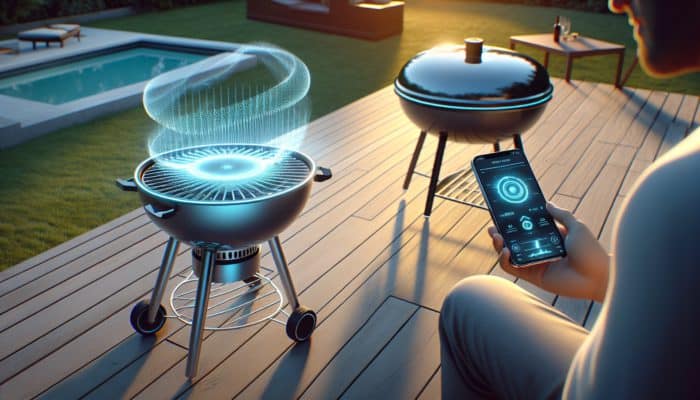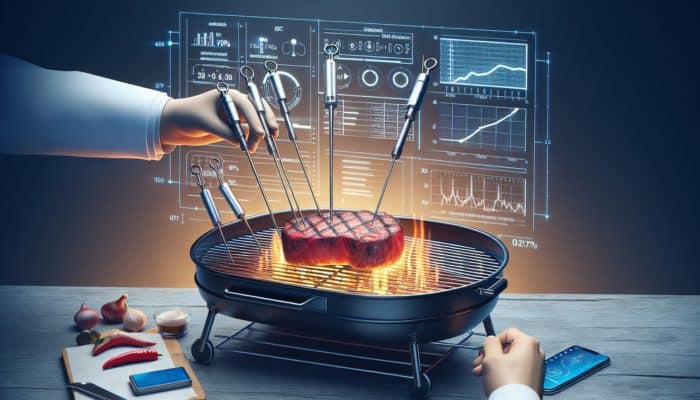Transform Your Grilling Experience Using Cutting-Edge BBQ Data Trackers
For passionate barbecue aficionados throughout the U.S., uncovering innovative tools to enhance the grilling journey is of utmost importance. Enter the world of BBQ data trackers, advanced devices meticulously crafted to revolutionise your outdoor cooking escapades. These are not mere fads; they are indispensable tools for aspiring chefs aiming to craft exceptional culinary creations right in their gardens. By diligently monitoring vital factors such as cooking duration and temperature, BBQ data trackers guarantee that your meats are perfectly cooked every time, dispelling the uncertainty that often results in overcooked or undercooked meals.
Delving into the Significance and Operation of BBQ Data Trackers

BBQ data trackers encapsulate cutting-edge technology that monitors an array of cooking metrics throughout your grilling adventures. These devices provide instantaneous insights into essential aspects such as temperature, cooking times, and sometimes even humidity levels. Picture being able to check the internal temperature of your brisket without lifting the grill lid! This not only conserves valuable cooking time but also prevents unnecessary heat loss, resulting in a more effective cooking experience. Many models are equipped with user-friendly applications that enable you to keep an eye on your barbecue directly from your patio chair, with some even sending alerts to your smartphone when your meat reaches the optimum temperature or when it's time to flip those burgers.
Fitted with highly precise sensors, these trackers collect crucial data necessary for achieving the perfect doneness for various meats. Whether you're smoking ribs, grilling steaks, or roasting vegetables, a BBQ data tracker can dramatically improve your cooking accuracy. Their dependability ensures that your dishes not only taste delightful but are also safe to consume. The merging of technology with traditional grilling techniques is fundamentally transforming our interaction with outdoor cooking, making it more intuitive and enjoyable for everyone involved.
Discover the Extensive Variety of BBQ Data Trackers on the Market
The array of BBQ data trackers available today is indeed impressive. You can select from standalone devices, smartphone-compatible models, and even Wi-Fi-enabled gadgets. Standalone BBQ trackers primarily focus on providing precise temperature readings, making them straightforward and user-friendly, often featuring clear displays for real-time data.
Smartphone-compatible models elevate the grilling experience by allowing you to connect your tracker directly to your mobile device. These devices typically come equipped with specialised applications that offer a user-friendly interface for monitoring your cooking progress. Features often include graphical data representations, historical data logging, and tailored alerts. This connectivity allows you to control the tracker remotely, granting you the freedom to enjoy your barbecue without being tethered to the grill at all times.
For the tech-savvy barbecue enthusiast, Wi-Fi-enabled BBQ data trackers provide seamless integration with your smart home ecosystem. These devices enable you to monitor your cooking from anywhere in your home, offering peace of mind while you entertain guests or relax with a drink. Additionally, some models can connect with other smart devices, such as smart speakers, allowing you to receive voice-activated updates on your cooking progress.
When choosing the ideal BBQ data tracker, consider your skill level, cooking style, and budget. While some users may appreciate the simplicity of standalone units, others might find that the advanced features of smartphone-compatible or Wi-Fi-enabled devices are essential for enhancing their grilling experience.
Exploring the Key Advantages of BBQ Data Trackers in Your Culinary Routine
Incorporating BBQ data trackers into your cooking routine can remarkably enhance your overall culinary experience, offering a wealth of benefits that extend far beyond basic temperature monitoring. One of the most prominent advantages is the heightened precision in cooking they provide. Achieving the perfect doneness for meats can be challenging, particularly for cuts like beef brisket or pork shoulder, which necessitate exact temperature control. BBQ data trackers eliminate the guesswork, allowing you to serve consistently perfectly cooked dishes.
Food safety is a crucial consideration for any griller. By employing a BBQ data tracker, you can ensure that your meats attain safe internal temperatures, thereby minimising the risk of foodborne illnesses. For example, poultry should reach an internal temperature of 165°F, while pork needs to be cooked to at least 145°F. A reliable data tracker enables you to quickly verify that these essential temperature thresholds are achieved, providing peace of mind for you and your guests alike.
Moreover, BBQ data trackers significantly enhance your overall enjoyment of grilling. The integration of technology allows you to engage with the cooking process in innovative ways that conventional grilling methods simply cannot match. You can experiment with diverse cooking techniques, such as smoking or indirect grilling, while gathering invaluable data that aids in refining your skills over time. This data-driven approach not only bolsters your confidence in your grilling capabilities but also inspires creativity as you explore new recipes and cooking methods.
In addition to these benefits, many BBQ data trackers offer insights that can assist in planning future grilling sessions. By analysing temperature and cooking data, you can identify trends that inform your cooking techniques. This means your next barbecue could surpass the last, leading to a continually evolving culinary journey.
Essential Factors to Consider When Selecting the Right BBQ Data Tracker

Choosing the right BBQ data tracker can greatly influence your outdoor cooking experiences. With a plethora of options available, there are several key aspects to evaluate to make an informed decision. Firstly, assess your connectivity preferences. If you value the convenience of monitoring from your smartphone, seek models that provide Bluetooth or Wi-Fi capabilities. Such features allow you to track your cooking without being physically tethered to your grill.
Next, consider ease of use. A user-friendly interface is vital, particularly if you are new to incorporating technology into your cooking routine. Look for models with clear displays and intuitive applications that guide you smoothly through both the setup and monitoring processes. The last thing you want is to struggle with complex features while trying to focus on your barbecue.
Another critical aspect is accuracy. A reliable BBQ data tracker should deliver dependable temperature readings. Choose devices that boast high precision and rapid response times, as these will provide the most accurate monitoring. Additionally, ensure that the tracker is compatible with your existing barbecue setup. Certain trackers may come with specific probes designed for particular types of grills or smokers, so it is vital to verify that any device you select integrates seamlessly with your equipment.
Lastly, consider your budget. BBQ data trackers are available at various price points, so determine which features are essential for you and which ones you can forgo. Investing in a high-quality model may yield superior long-term results compared to opting for a cheaper, less reliable option. By keeping these factors in mind, you will be able to select a BBQ data tracker that caters to your grilling needs while enhancing your overall barbecue experience.
Effortlessly Setting Up Your BBQ Data Tracker for Optimal Use
The thrill of using a new BBQ data tracker can quickly diminish if the setup process is overly complex. Fortunately, with the right guidance, you can have your device ready for action in no time, set to elevate your grilling prowess to new heights.
Selecting the Ideal Tracker for Your Unique Requirements
Before embarking on the setup process, it’s crucial to ensure that you’ve selected the right BBQ data tracker tailored to your specific needs. Factors such as your grilling habits, the type of BBQ equipment you possess, and your budget will significantly influence this decision. If you frequently host large gatherings or family barbecues, investing in a more advanced tracker with multiple probes might be essential, as it will enable you to monitor different meats simultaneously.
Conversely, if you are a casual griller, a simpler, single-probe model may suffice. For those who take pleasure in smoking meats, consider trackers that are specifically designed for low and slow cooking, as they often include features that facilitate monitoring prolonged cooking times. Budget is also a vital factor in this decision. While higher-end trackers may offer additional features, it’s crucial to weigh these against how often you intend to use them and whether the added capabilities justify the investment.
Conducting thorough research and reading customer reviews can be invaluable in this process. Look for testimonials that highlight the ease of setup and reliability of the tracker. Once you’ve identified a model that aligns with your needs, you can proceed to the setup process with confidence, knowing you’ve made an informed choice.
Properly Installing the Tracker on Your BBQ

Installing your BBQ data tracker typically involves securely attaching the device to your grill, ensuring it is positioned accurately for reliable readings. Most manufacturers provide thorough instructions, making it essential to follow these guidelines closely to avoid complications. Generally, you will need to attach the probe(s) to your meat, ensuring they penetrate deeply enough to provide precise internal temperature readings.
Correct positioning is vital; place the tracker in a location that allows it to gauge the heat both inside and outside your grill. Avoid placing it too close to any flames or direct heat sources, as this can lead to inaccurate readings. Ensure that any wires or cables do not interfere with your cooking process, as this might introduce hazards while grilling.
If your tracker features a magnetic back or clamps, these options can simplify installation, allowing you to mount it securely on your grill. Confirm that all components are fastened correctly and that the device is stable before igniting your barbecue. A well-installed tracker will provide you with trustworthy data throughout your cooking session, significantly enhancing your overall experience.
Connecting Your Tracker to a Device for Seamless Monitoring
Once your BBQ data tracker is correctly installed, the next crucial step is to connect it to your smartphone or other devices. Many modern BBQ trackers come with companion applications that facilitate seamless syncing and monitoring. Begin by downloading the necessary app from your device’s app store. Once installed, follow the setup instructions provided by the app to pair it with your BBQ tracker.
Typically, this process requires enabling Bluetooth or Wi-Fi on your device while ensuring that the tracker is powered on. Once connected, you should have access to real-time data regarding your cooking progress, enabling you to monitor temperatures from any location within range. This feature is particularly beneficial during social gatherings, as it allows you to engage with guests while keeping an eye on your food.
As you connect, you may also have the option to customise settings according to your preferences, such as establishing alerts for specific temperature thresholds. This customisation enables you to tailor the experience for different types of meats or cooking styles, ensuring optimal results every time you fire up the grill.
Calibrating Your BBQ Data Tracker for Accurate Readings
Calibration is a vital step to ensure that your BBQ data tracker delivers accurate readings. Most devices come with guidelines on how to calibrate them correctly; this is a step you should never overlook. Calibration typically involves using a known temperature source, such as boiling water or ice, to verify that the tracker is providing correct readings.
For instance, when using boiling water, it should read approximately 212°F at sea level. If your tracker displays a different temperature, you may need to adjust it according to the manufacturer’s instructions. Calibration can also help you account for any discrepancies that may arise from environmental factors, such as altitude or humidity, which can influence temperature readings.
Regular calibration—especially before significant cooking sessions—ensures that your BBQ data tracker remains trustworthy over time. Some advanced models even feature self-calibration capabilities, simplifying this process and enhancing accuracy. Keeping your device well-calibrated will greatly contribute to achieving the perfect cook every time you fire up the grill.
Maintaining and Troubleshooting Your Tracker for Enhanced Longevity
Proper maintenance of your BBQ data tracker is essential for ensuring its longevity and consistent performance. Regular cleaning is crucial, especially if you use the device frequently. Many models are designed to withstand outdoor conditions, but it’s still wise to wipe down the exterior and clean the probes after each use. Avoid harsh chemicals; instead, opt for mild soap and water to maintain its functionality.
In addition to cleaning, refer to the manufacturer’s maintenance recommendations, which may include specific care tips tailored to the tracker’s materials and design. Storing your BBQ data tracker in a cool, dry location when not in use will also help protect it from potential damage.
Troubleshooting common issues can save you time and frustration. If you experience connectivity problems, ensure that both your tracker and the device it’s connected to have Bluetooth or Wi-Fi enabled. Restarting both devices often resolves these issues. If you encounter inaccurate readings, recheck the calibration and ensure that the probes are clean and properly inserted into your food.
Many manufacturers also provide online support resources, including FAQs and troubleshooting guides, which can be invaluable when addressing common challenges. Taking the time to maintain and troubleshoot your BBQ data tracker will not only enhance your grilling experiences but also extend the lifespan of this invaluable tool.
Maximising BBQ Data Trackers for Different Cooking Techniques
BBQ data trackers serve as versatile companions in outdoor cooking, capable of enhancing various cooking techniques, whether you’re grilling, smoking, or roasting. Let’s explore how to effectively utilise these devices for each method, ensuring mouthwatering results every time.
Mastering Grilling Precision with BBQ Data Trackers
Grilling is a cherished American tradition, and employing a BBQ data tracker dispels the uncertainty involved in achieving that perfect sear on your steaks or burgers. Begin by preheating your grill to the desired temperature, utilising your tracker to monitor both the grill’s heat and the internal temperature of the meat you’re preparing.
With a reliable BBQ data tracker, you can maintain your grill at the ideal temperature throughout the cooking process. For instance, most steaks are best cooked at high temperatures ranging from 450°F to 500°F to achieve an ideal medium-rare finish. By using your tracker to keep tabs on both the grill and meat temperatures, you can prevent overcooking and achieve that perfect crust while keeping the interior juicy and flavourful.
Additionally, many BBQ data trackers feature alert settings that notify you when your meat reaches the desired temperature. This capability is particularly useful when entertaining guests, as it allows you to focus on socialising while ensuring your food cooks perfectly. With accurate monitoring and the ability to make necessary adjustments, your grilling sessions will not only be more efficient but also significantly more enjoyable.
Smoking Meats with the Support of BBQ Data Trackers
Smoking meats is an art that demands patience and precision, making BBQ data trackers indispensable for this technique. Achieving ideal low and slow cooking conditions can be challenging, but a data tracker assists you in maintaining consistent temperatures over prolonged periods.
Start by setting your smoker to the desired temperature, typically between 225°F and 250°F for most types of meats. Throughout the cooking process, the tracker will provide real-time updates on the internal temperature of your meat. This feature allows you to adjust the smoker’s heat source and wood chips without frequently opening the smoker lid, which could cause undesirable temperature fluctuations.
Moreover, smoking times can vary significantly based on both the type of meat and its size. By utilising your BBQ tracker’s recorded data, you can analyse smoking times from previous cooking sessions to refine your techniques. Over time, you’ll gain a deeper understanding of how different woods influence flavour and how various meats respond to extended smoking durations. This analytical approach will elevate your smoking skills and enhance the overall quality of your barbecue.
Roasting with the Assistance of BBQ Data Trackers
Roasting meats is another area where BBQ data trackers excel. The key to success lies in ensuring even cooking throughout the meat. A BBQ tracker allows you to closely monitor the internal temperature, ensuring that your roast reaches the desired doneness without overcooking the exterior.
Begin by preheating your grill or smoker and placing the meat in a central position. As it cooks, keep an eye on the temperature data provided by your tracker. For instance, when roasting chicken, reaching an internal temperature of 165°F is crucial for ensuring it’s fully cooked while remaining juicy and tender. Utilise the alerts on your BBQ data tracker to notify you when the meat approaches the desired temperature.
Furthermore, BBQ data trackers empower you to experiment with different seasoning blends and cooking techniques, enabling you to discover the perfect combination that aligns with your taste preferences. With precise monitoring, you’ll gain confidence in your roasting abilities, allowing you to prepare impressive meals for family gatherings or special occasions.
Leveraging BBQ Data for Exceptional Cooking Results
The true value of a BBQ data tracker extends beyond its real-time monitoring capabilities; it also lies in the ability to analyse the data it collects. By reviewing this information, you can make informed decisions that enhance your future cooking endeavours.
Utilising Temperature Data to Refine Cooking Techniques
After each grilling or smoking session, dedicate some time to review the temperature data collected by your BBQ tracker. This analysis can unveil patterns that inform your cooking strategies and assist you in improving over time. For example, you might discover that certain cuts of meat require longer cooking times than anticipated or that specific temperature ranges yield superior outcomes.
By identifying these trends, you can adjust your cooking techniques accordingly. If you find that your pork ribs consistently finish too quickly at a certain temperature, consider lowering the heat or extending cooking time for a more tender result. Understanding how different meats respond to various conditions will empower you to achieve consistently high-quality results.
Additionally, many BBQ data trackers retain historical data, allowing you to compare results across different cooking sessions. Use this information to create your very own cooking log, documenting successful techniques and any modifications you made along the way. Over time, this log will serve as a valuable resource, guiding you to effortlessly replicate your best barbecues.
Tracking Cooking Time for Optimal Outcomes
In the realm of barbecue, timing is critical. By utilising your BBQ data tracker to monitor cooking times, you can optimise your grilling process, facilitating better planning during cookouts. By noting how long it takes to reach specific temperatures for different types of meats, you can create a more efficient cooking schedule for future barbecues.
For example, if you find that your brisket typically requires six hours to reach the desired internal temperature, you can plan your cooking start time accordingly for future gatherings. This foresight will also allow you to coordinate other dishes, such as sides or appetizers, ensuring that everything is ready simultaneously.
Additionally, some BBQ data trackers come equipped with timers that can assist in managing multiple dishes simultaneously. This feature is particularly advantageous when cooking for larger groups, where timing can easily become chaotic. By effectively tracking cooking times, you can make strategic decisions that lead to more enjoyable and less stressful barbecue experiences.
Comparing Data Across Multiple Cooking Sessions for Ongoing Improvement
One of the most powerful features of employing a BBQ data tracker is the ability to compare data from various cooking sessions. Each barbecue presents unique variables, from weather conditions to the specific cuts of meat used. By analysing data from multiple cooks, you can identify what worked well and what didn’t, facilitating continuous improvement in your grilling skills.
Look for discrepancies in temperature readings or cooking times across different sessions and assess how those differences impacted the final results. For instance, if you note that a particular rub performed better on a rainy day, you might adjust your approach based on weather conditions in the future. This analytical mindset will not only enhance your understanding of barbecue techniques but also help you become a more versatile grill master.
Moreover, sharing your data with fellow barbecue enthusiasts can yield valuable insights and tips. Friends and family may offer alternative perspectives on your cooking methods, potentially highlighting areas for improvement. By continually refining your techniques based on data, you will ensure that your barbecue skills remain sharp and innovative.
Ensuring Longevity Through Proper Maintenance and Calibration of Your BBQ Data Tracker
Proper maintenance and calibration of your BBQ data tracker are essential for guaranteeing accurate readings and long-term functionality. By adhering to a few simple steps, you can keep your device in excellent condition and ready for your next cookout.
Routine Cleaning and Maintenance for Optimal Performance
Your BBQ data tracker is an investment in your grilling success, and like any tool, it requires regular cleaning and maintenance to function at its best. After each use, take a few moments to clean the device and its components. Depending on the model, this may involve wiping down sensors, probes, and exterior surfaces to remove grease, food particles, or moisture.
Using mild soap and warm water is generally sufficient for cleaning. Avoid using abrasive materials that could scratch the surface or damage internal components. Pay special attention to the probes, as they often come into direct contact with food. Ensure they are thoroughly cleaned to prevent cross-contamination during cooking.
In addition to cleaning, check for any signs of wear or damage to the device. Look for frayed wires, loose parts, or damaged displays. If you notice any issues, consult the manufacturer’s recommendations for repairs or replacements. Regular maintenance will extend the life of your tracker and ensure it continues to provide accurate data for years to come.
Calibration Procedures for Optimal Device Performance
Calibration is a critical practice that guarantees your BBQ data tracker delivers precise readings. Many manufacturers offer specific guidelines for calibration, which often involves using a known temperature source such as boiling water or ice to verify the device’s accuracy.
To calibrate, fill a container with ice and water for a cold calibration or boil a pot of water for a hot calibration. Insert the probe into the ice water or boiling water and wait for the reading to stabilise. If the reading does not align with the expected temperature (32°F for ice water or 212°F for boiling water), follow the manufacturer’s instructions for adjusting the calibration settings.
Regular calibration is especially important if you notice inconsistencies in the temperature readings during your cooking sessions. Checking your tracker before significant cooks will help ensure its accuracy, enabling you to achieve consistently excellent results.
Troubleshooting Common Challenges with Your BBQ Tracker
Even the most reliable BBQ data trackers can encounter issues from time to time. Familiarising yourself with common problems and their solutions can save you time and frustration. For instance, if you experience connectivity issues, ensure that your device and tracker are within range and that Bluetooth or Wi-Fi is enabled.
If you notice inaccurate temperature readings, recalibrate your tracker using the methods discussed earlier. It’s also wise to check that the probes are clean and correctly positioned within the meat. If problems persist, consult the user manual or reach out to the manufacturer’s support team for assistance.
Numerous BBQ data trackers also have online community forums where users share tips and solutions for troubleshooting common issues. Engaging with this community can provide insights into how others have resolved similar problems, helping you get back to grilling in no time.
Keeping Firmware and Software Updated for Peak Performance
To ensure that your BBQ data tracker operates at peak performance, it’s crucial to keep its firmware and software updated. Many modern devices will provide notifications within their companion apps when updates are available. These updates can enhance performance, introduce new features, and resolve bugs that may affect functionality.
Regularly checking for updates is straightforward; simply follow the prompts within the app to initiate the update process. It’s advisable to keep your device plugged in or charged during this process to avoid interruptions. By staying current with firmware and software updates, you’ll maximise the performance and reliability of your BBQ data tracker.
Proper Storage Techniques for Your Tracker
When not in use, properly storing your BBQ data tracker will shield it from damage and prolong its lifespan. Opt for a cool, dry location for storage, away from direct sunlight and moisture. Avoid areas where it may be exposed to extreme temperature fluctuations, as this can adversely affect its electronic components.
If your tracker includes a storage case, utilise it to protect the device from dust and physical damage. Keeping all components organised in one place will also simplify locating and using them when you’re ready to grill again. Proper storage ensures that your BBQ data tracker will be poised to perform when your next barbecue adventure arrives.
Exploring Advanced Features of BBQ Data Trackers
As technology advances, BBQ data trackers are becoming increasingly sophisticated, offering innovative features that can significantly enhance your grilling experience. From customisable alerts to smart home integrations, these functionalities can simplify the cooking process and spark your culinary creativity.
Setting Custom Alerts and Notifications for Enhanced Cooking Control
One of the standout features of modern BBQ data trackers is their ability to configure custom alerts and notifications. This functionality allows you to tailor your cooking experience to match your specific preferences and requirements. For example, you can set alerts to notify you when meats reach predetermined temperatures or when it’s time to flip or baste your food.
These alerts can be delivered through the companion app on your smartphone, ensuring that you’re always informed, even when you’re not physically near the grill. This capability is particularly beneficial during larger gatherings, where you might be preoccupied with hosting guests. Rather than constantly checking on your cooking progress, you can rely on timely notifications to maintain control over your barbecue.
Some advanced models offer multiple alert options, enabling you to set different notifications for various meats or dishes. This added customisation can enhance your overall cooking efficiency and ensure that everything is cooked to perfection. By leveraging these alerts, you can create a more enjoyable and stress-free grilling experience.
Integration with Smart Home Technologies for Ultimate Convenience
The rise of smart home technology has facilitated the seamless integration of BBQ data trackers with other smart devices. This feature can elevate your grilling sessions, allowing for centralised control and monitoring from your home automation system.
Imagine being able to monitor your BBQ data tracker through voice commands via a smart speaker like Amazon Echo or Google Home. You can inquire about updates on your cooking progress without needing to manually check your device. This integration not only adds convenience but also allows you to engage with your barbecue in a modern, tech-savvy manner.
Furthermore, some BBQ trackers can be programmed to work in conjunction with other smart devices, such as smart thermometers or automatic grill igniters. This interconnected system can streamline your cooking process, making everything from preparation to cooking more efficient. As smart home technology continues to evolve, the possibilities for BBQ data trackers will expand, providing even more opportunities to enhance your outdoor cooking experience.
Commonly Asked Questions About BBQ Data Trackers
What function does a BBQ data tracker serve?
A BBQ data tracker is a device designed to monitor essential cooking parameters like temperature and time, enabling you to achieve precise results when grilling or smoking meats.
How can a BBQ data tracker improve my cooking?
By providing real-time temperature readings and alerts, a BBQ data tracker removes guesswork and helps ensure that meats are cooked to the correct doneness.
What types of BBQ data trackers can I find?
BBQ data trackers come in various formats, including standalone units, smartphone-integrated models, and Wi-Fi-enabled devices, catering to different cooking styles and preferences.
How do I choose the ideal BBQ data tracker for my needs?
Consider factors like connectivity options, ease of use, accuracy, and compatibility with your existing BBQ setup to select the perfect tracker for your requirements.
How often should I calibrate my BBQ data tracker?
It’s advisable to calibrate your BBQ data tracker regularly, especially before significant cooking sessions, to ensure accurate temperature readings.
Can I utilise a BBQ data tracker for smoking meats?
Yes, BBQ data trackers are particularly beneficial for smoking, as they help maintain consistent low temperatures over extended cooking durations.
What should I do if my BBQ data tracker displays inaccurate readings?
If your tracker shows inaccurate readings, recalibrate it using a known temperature source and ensure the probes are clean and correctly positioned.
How can I maintain my BBQ data tracker?
Regularly clean your BBQ data tracker, adhere to the manufacturer's maintenance recommendations, and store the device properly when not in use to ensure longevity.
Are custom alerts beneficial for grilling?
Absolutely! Custom alerts allow you to tailor notifications based on your cooking preferences, enhancing your overall grilling experience by keeping you informed.
Can BBQ data trackers connect with smart home systems?
Many contemporary BBQ data trackers can seamlessly integrate with smart home systems, allowing for centralised control and monitoring through voice commands or companion apps.
Connect with us on Facebook for more grilling tips and tricks!
The Article How to Use BBQ Data Trackers: A Comprehensive Guide appeared first on https://pitmastersarsenal.com
The Article BBQ Data Trackers: Your Ultimate Guide to Usage Was Found On https://limitsofstrategy.com

